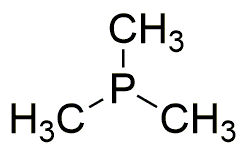Trimethylphosphine is widely utilized in research focused on various applications:
- Organic Synthesis: It serves as a crucial reagent in the synthesis of phosphine oxides and phosphonium salts, which are important intermediates in organic chemistry.
- Catalysis: This compound is used as a ligand in transition metal catalysis, enhancing reaction efficiency and selectivity in processes such as cross-coupling reactions.
- Pharmaceutical Development: Trimethylphosphine is involved in the development of pharmaceuticals, particularly in the synthesis of biologically active compounds.
- Material Science: It plays a role in the production of phosphine-based polymers, which are utilized in various applications including coatings and adhesives.
- Analytical Chemistry: The chemical is employed in analytical techniques for detecting and quantifying phosphine and related compounds, aiding in environmental monitoring.
General Information
Properties
Safety and Regulations
Applications
Trimethylphosphine is widely utilized in research focused on various applications:
- Organic Synthesis: It serves as a crucial reagent in the synthesis of phosphine oxides and phosphonium salts, which are important intermediates in organic chemistry.
- Catalysis: This compound is used as a ligand in transition metal catalysis, enhancing reaction efficiency and selectivity in processes such as cross-coupling reactions.
- Pharmaceutical Development: Trimethylphosphine is involved in the development of pharmaceuticals, particularly in the synthesis of biologically active compounds.
- Material Science: It plays a role in the production of phosphine-based polymers, which are utilized in various applications including coatings and adhesives.
- Analytical Chemistry: The chemical is employed in analytical techniques for detecting and quantifying phosphine and related compounds, aiding in environmental monitoring.
Documents
Safety Data Sheets (SDS)
The SDS provides comprehensive safety information on handling, storage, and disposal of the product.
Product Specification (PS)
The PS provides a comprehensive breakdown of the product’s properties, including chemical composition, physical state, purity, and storage requirements. It also details acceptable quality ranges and the product's intended applications.
Certificates of Analysis (COA)
Search for Certificates of Analysis (COA) by entering the products Lot Number. Lot and Batch Numbers can be found on a product’s label following the words ‘Lot’ or ‘Batch’.
Numéro de catalogue
Numéro de lot/série
Certificates Of Origin (COO)
This COO confirms the country where the product was manufactured, and also details the materials and components used in it and whether it is derived from natural, synthetic, or other specific sources. This certificate may be required for customs, trade, and regulatory compliance.
Numéro de catalogue
Numéro de lot/série
Safety Data Sheets (SDS)
The SDS provides comprehensive safety information on handling, storage, and disposal of the product.
DownloadProduct Specification (PS)
The PS provides a comprehensive breakdown of the product’s properties, including chemical composition, physical state, purity, and storage requirements. It also details acceptable quality ranges and the product's intended applications.
DownloadCertificates of Analysis (COA)
Search for Certificates of Analysis (COA) by entering the products Lot Number. Lot and Batch Numbers can be found on a product’s label following the words ‘Lot’ or ‘Batch’.
Numéro de catalogue
Numéro de lot/série
Certificates Of Origin (COO)
This COO confirms the country where the product was manufactured, and also details the materials and components used in it and whether it is derived from natural, synthetic, or other specific sources. This certificate may be required for customs, trade, and regulatory compliance.


